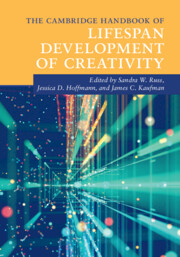Book contents
- The Cambridge Handbook of Lifespan Development of Creativity
- The Cambridge Handbook of Lifespan Development of Creativity
- Copyright page
- Dedication
- Contents
- Figures
- Tables
- Contributors
- Acknowledgments
- Introduction
- Part I Core Concepts of Lifespan Creativity Development
- Part II The Development of Creativity
- Part III Modes of Enhancement
- Part IV Environments and Contexts
- Part V Special Populations
- 23 The Development of Gifted and Talented Students’ Creativity in School Contexts
- 24 Creative Play in Children with Neurodevelopmental Disorders
- 25 Eminent Creators
- Epilogue: What Have We Learned?
- Index
- References
Epilogue: What Have We Learned?
from Part V - Special Populations
Published online by Cambridge University Press: 19 November 2021
- The Cambridge Handbook of Lifespan Development of Creativity
- The Cambridge Handbook of Lifespan Development of Creativity
- Copyright page
- Dedication
- Contents
- Figures
- Tables
- Contributors
- Acknowledgments
- Introduction
- Part I Core Concepts of Lifespan Creativity Development
- Part II The Development of Creativity
- Part III Modes of Enhancement
- Part IV Environments and Contexts
- Part V Special Populations
- 23 The Development of Gifted and Talented Students’ Creativity in School Contexts
- 24 Creative Play in Children with Neurodevelopmental Disorders
- 25 Eminent Creators
- Epilogue: What Have We Learned?
- Index
- References
Summary
What have we learned about the development of creativity throughout the lifespan? The rich and comprehensive review by Bornstein (Chapter 4) captures the complexity of creativity within a developmental framework. How do we integrate the constructs and empirical findings in the field of creativity with developmental approaches? Understanding the development of creativity requires perspectives from different disciplines and a number of different investigative approaches, which this Handbook has provided. Here, we highlight some areas of consensus and implications for the future.
- Type
- Chapter
- Information
- The Cambridge Handbook of Lifespan Development of Creativity , pp. 552 - 558Publisher: Cambridge University PressPrint publication year: 2021



